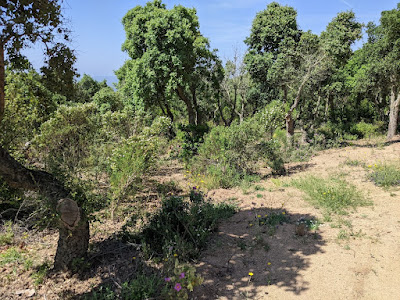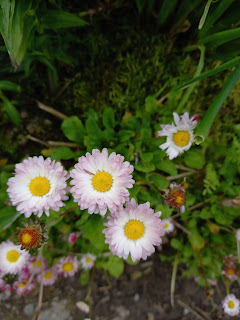Finally, after multiple thwarted attempts to make it, I arrived in Sardegna, Italy to meet Yvo Zanev and take a look at a 35.2 ha plot he and his brother have recently taken on. It's a magical spot!
Their plan for the site is to implement a regenerative landscape design with their primary goal being to create a small settlement on the site and grow food and resources to support those living there and run activities and events from the property. Yvo, his brother, and his brother's girlfriend have already moved onto the site last year and have installed access, water and electricity, started to plant out a forest garden, and set up some very comfortable tents, a kitchen area, sauna and storage.
The Site
- Information about any development restrictions there are on the property, specifically; are there protected zones (nature reserves), are there restrictions to pond building, and if so up to what size (in m3)?
- Locations of Electricity, Gas, and Water Pipes/Lines
- Access -rights of way.
- Ownership disputes/issues
- Locations of nearest public transport links, airports, etc.
- A list of the client's objectives and goals.
- A cadastral of the property on google earth with a topography map of the site or better yet a DTM at 1-2m resolution. This is really helpful to plan the route across the site and locate areas of interest to concentrate observations before arriving.
Want to learn more about Regenerative Landscape Design? Join The Bloom Room!
The Bloom Room is designed to create a space for more in-depth learning, for sharing projects and ideas, for seeking advice and discovering opportunities.
Ultimately, it aims to build a more intimate, interactive, and actionable relationship between members, a way for the Bloom Room community to support each other’s projects and learning journeys, and to encourage and facilitate the design, build, and management of more regenerative landscapes across our planet.
What you can expect as a member of the Bloom Room
As a member of the Bloom Room you can expect;
Access to an interactive forum where you can ask questions, direct what type of content you would like to see as well as share your own content and projects.
Monthly live session featuring general Q&A and tutorials on design software for creating and presenting polycultures.
Live session every month for members to showcase your projects, plans, designs, and gardens, with guest speakers from the community.
Full Access to all of the content on Substack
A 50% discounts on all of our online courses
Future opportunities to join our Global Regenerative Landscape Design and Consultancy Service, with potential roles for those with the will and skill to join our design team.
An opportunity to take part in the group ownership of a Regenerative Landscape. You will find more details on that here.
Become a paid subscriber to our Substack to join. The annual subscription is currently $70 and the monthly subscription is $7 (monthly subscription excludes discounts for products and services) . You can join here, we look forward to meeting you!
Site Biodiversity
 |
Tracing signs of water erosion to the source, locating water sources, and finding areas where flows and gathers during heavy rains is always a priority when observing a site in a dry climate and the first two days were dedicated to this. The site has great potential for rainwater harvesting and with some relatively simple earthworks, much of the water currently draining off the site and causing erosion could be either, distributed more evenly over the landscape or, stored in reservoirs. There were already a few places on the land where water was naturally accumulating, the most prominent being a wetland area that appeared to be fed with a slight trickle from a natural spring. You can see the wetland pictured below, easily identified by the dark green clumps of rushes (Juncaceae), and in the very low area, the ground was moist with water on the surface in places.
- Create a master plan/ vision for the site. Start to map your plans and make numerous iterations until a clear option presents itself
- Get your water/irrigation sources worked out first and ensure they are reliable throughout the year (especially during the heat waves and droughts) If you have a very wet site, get your drainage and flood relief worked out.
- Establish access around the site that works with the topography e.g. eliminates erosion, harnesses water harvesting potential, or drainage.
- When managing water flows across the site (rainwater runoff or pumped water) have the overflow route planned and implemented.
- The access layout will make apparent subdivisions within the plot that can be assigned to purposes that best suit the locations, i.e orchard, wild area, intensive forest garden, vegetable garden, meadow, etc. Create a broad vision of what you want to do in each subplot.
- Break down your plan into manageable pieces, focus on the most relevant/essential aspect of the plan first and only move on when you are comfortable and confident it is complete.
- Clear only the areas that you intend to immediately work on, otherwise, leave them to grow wild
- Be aware of the maximum width and height of the trees and shrubs you will grow to avoid overcrowding them when they are maturing and just starting to become productive.
- Size your access up to the width of the machinery you will be using and design your corners so that the machinery can comfortably and safely turn corners
- Annual vegetable production for domestic production is best concentrated in a very small area that will get daily attention. Load up this area with the best soil and have a reliable and easy-to-use irrigation system in place for the crops and make it easy and comfortable to walk around and work in.
Support Our Project
If you appreciate the work we are doing you can show your support in several ways.
Become a member of the Bloom Room. A $70 annual or $7 per month subscription to our Substack provides you with access to live sessions, design tutorials, a members forum and more, see details here.
Make a purchase of plants or seeds from our Nursery or Online Store
Joining us for one of our Practical Courses or Online Courses
Comment, like, and share our content on social media.
If you appreciate the work we are doing you can show your support in several ways.
Become a member of the Bloom Room. A $70 annual or $7 per month subscription to our Substack provides you with access to live sessions, design tutorials, a members forum and more, see details here.
Make a purchase of plants or seeds from our Nursery or Online Store
Joining us for one of our Practical Courses or Online Courses
Comment, like, and share our content on social media.
Regenerative Landscape Design - Online Interactive Course
Want to learn how to design, build and manage regenerative landscapes? Join us on our Regenerative Landscape Design - Online Interactive Course. We look forward to providing you with the confidence, inspiration, and opportunity to design, build and manage regenerative landscapes, gardens, and farms that produce food and other resources for humans while enhancing biodiversity.
You can find the course details here and at the moment we have a $350 ( 20%) discount for full enrollment to the course. Just use RLD2024 in the promo code section of the registration form to receive your discount.
Want to learn how to design, build and manage regenerative landscapes? Join us on our Regenerative Landscape Design - Online Interactive Course. We look forward to providing you with the confidence, inspiration, and opportunity to design, build and manage regenerative landscapes, gardens, and farms that produce food and other resources for humans while enhancing biodiversity.
You can find the course details here and at the moment we have a $350 ( 20%) discount for full enrollment to the course. Just use RLD2024 in the promo code section of the registration form to receive your discount.


.jpg)
.jpg)




















.jpg)
.jpg)
.jpg)





.jpg)

.jpg)







.jpg)












